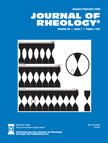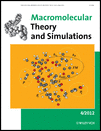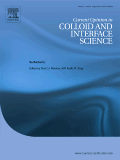
JOURNAL OF RHEOLOGY
Scope & Guideline
Connecting Theory and Application in Rheology
Introduction
Aims and Scopes
- Rheological Behavior of Complex Fluids:
The journal covers fundamental and applied research on the rheological properties of complex fluids including polymers, suspensions, emulsions, and biomaterials, focusing on their flow and deformation characteristics. - Innovative Experimental Techniques:
Research utilizing advanced experimental methods such as oscillatory shear, microrheology, and rheo-optical techniques to elucidate the mechanical properties and behaviors of materials under different conditions. - Theoretical and Computational Modeling:
Papers often include theoretical frameworks and computational models that describe the rheological behavior of materials, providing insights into molecular dynamics, constitutive equations, and simulation techniques. - Applications in Industry and Biomedicine:
The journal highlights research relevant to industrial applications such as food processing, cosmetics, and pharmaceuticals, as well as studies focusing on biological materials like human blood and tissue. - Interfacial Rheology:
A significant focus on the rheological properties at interfaces, exploring the behavior of materials at liquid-liquid and solid-liquid interfaces, which is crucial for applications in coatings, emulsions, and foams.
Trending and Emerging
- Machine Learning and Data-Driven Approaches:
There is a growing trend towards incorporating machine learning and data-driven methodologies in rheological research, allowing for enhanced predictions and characterizations of material behavior. - Nanomaterials and Complex Suspensions:
Recent publications increasingly focus on the rheological properties of nanomaterials and complex suspensions, particularly in relation to their mechanical performance and applications in advanced materials. - Biomaterials and Hemorheology:
Research exploring the rheological properties of biological fluids, particularly human blood, has gained prominence, underscoring the importance of understanding rheology in medical and biological contexts. - Interfacial Dynamics and Rheology:
Emerging studies emphasize interfacial phenomena and their rheological implications, particularly in systems involving emulsions, foams, and colloidal interactions, highlighting the significance of interfaces in material behavior. - Nonlinear and Transient Rheology:
There is an increased focus on nonlinear and transient rheological behaviors, investigating how materials respond under varying stress and strain conditions, which is crucial for understanding real-world applications.
Declining or Waning
- Traditional Polymer Rheology:
There has been a noticeable decline in studies solely focused on basic polymer rheology without innovative applications or methodologies, reflecting a potential shift towards more complex systems and interdisciplinary research. - Static Measurements:
Research focused primarily on static rheological measurements, such as steady shear viscosity without dynamic analysis, seems to be waning, indicating a trend towards exploring dynamic behaviors and time-dependent properties. - Viscoelasticity in Simple Fluids:
The exploration of viscoelastic properties in simple Newtonian fluids has decreased, as more emphasis is placed on complex fluids and non-Newtonian behaviors that require deeper analysis and more sophisticated modeling techniques.
Similar Journals

BIORHEOLOGY
Advancing Insights into Biological Fluid DynamicsBIORHEOLOGY is a peer-reviewed journal published by IOS PRESS, dedicated to the interdisciplinary field of biorheology, which studies the flow properties of biological fluids and the mechanical behavior of biological tissues. With its ISSN 0006-355X and e-ISSN 1878-5034, this journal has been a vital source of scientific knowledge since its inception in 1965, with coverage extending to recent years and into 2024. As a respected publication within the realms of physiology and biochemistry, it is classified in Q4 in both Physiology and Medical Physiology categories as of 2023, showcasing its niche position within the academic community. The journal primarily aims to disseminate research findings that advance our understanding of biorheological principles and their applications in medicine and biology. Although not listed as open access, BIORHEOLOGY provides essential insights to researchers, professionals, and students eager to explore the complexities of fluid mechanics in biological systems, making it a valuable resource for fostering innovation and collaboration across scientific disciplines.

Applied Mechanics Reviews
Connecting Researchers with Groundbreaking Discoveries.Applied Mechanics Reviews, a prestigious journal published by ASME (American Society of Mechanical Engineers), is an essential resource in the field of mechanical engineering. With an impact factor reflecting its high relevance and rigorous peer-review process, this journal holds a commendable Q1 ranking in the 2023 category quartiles and is positioned at an impressive rank of #7 out of 672 in Scopus rankings, placing it in the 99th percentile. The journal, with an ISSN of 0003-6900 and E-ISSN of 2379-0407, serves as a vital platform for the dissemination of groundbreaking research, offering a comprehensive overview of applied mechanics, spanning theoretical developments to practical applications. Although it does not provide open access options, the insights published within these pages are invaluable for researchers, professionals, and students eager to enhance their knowledge and stay abreast of the latest advancements. With volumes dating back to 1965 and continuing through 2024, Applied Mechanics Reviews remains a cornerstone of the mechanical engineering community, fostering innovation and collaboration across various domains of engineering.

SOFT MATERIALS
Shaping the Future of Nanotechnology and PolymersSOFT MATERIALS is a premier journal specializing in the dynamic and interdisciplinary fields of chemistry, condensed matter physics, and materials science. Published by Taylor & Francis Inc., the journal serves as a vital platform for researchers and professionals to disseminate their cutting-edge findings related to soft materials, which are pivotal to advancements in various applications such as nanotechnology, biotechnology, and polymers. With an ISSN of 1539-445X and an E-ISSN of 1539-4468, this journal has successfully built a reputation within the academic community since its inception in 2004. As of 2023, SOFT MATERIALS is ranked within the Q3 category in Chemistry (miscellaneous), Condensed Matter Physics, and Materials Science (miscellaneous), reflecting its growing influence as a respected source of scientific knowledge. Although it does not currently operate under an open access model, its substantial impact factor and Scopus rankings, which place it in the 39th to 45th percentile across pertinent categories, highlight its quality and significance in fostering research collaboration and discourse among scholars and practitioners worldwide. The journal's objectives include enhancing the understanding of the physical, chemical, and material properties of soft materials, making it an essential resource for students, researchers, and professionals passionate about materials innovation and development.

MACROMOLECULAR THEORY AND SIMULATIONS
Advancing the Frontiers of Macromolecular ResearchMACROMOLECULAR THEORY AND SIMULATIONS, published by WILEY-V C H VERLAG GMBH in Germany, serves as a crucial platform for researchers and professionals in the fields of condensed matter physics, inorganic chemistry, materials chemistry, organic chemistry, and polymer science. Since its inception in 1992, the journal has provided a valuable resource for the dissemination of innovative theoretical and simulation-based research pertaining to macromolecules. With a current ranking in the Q3 quartile across multiple categories – including a rank of #98 in Polymers and Plastics and #50 in Inorganic Chemistry as of 2023 – it offers a unique opportunity for authors to engage with a global audience. Although it does not provide open access, the journal remains dedicated to advancing knowledge and fostering scholarly communication within its diverse scientific community, thus significantly contributing to developments in material science and polymer research. As it progresses into its convergence year of 2024, MACROMOLECULAR THEORY AND SIMULATIONS continues to inspire ground-breaking studies and elevate discourse, making it an essential resource for students and established researchers alike.

JOURNAL OF ELASTICITY
Pioneering Research in the Mechanics of MaterialsJOURNAL OF ELASTICITY is a prestigious peer-reviewed journal dedicated to the study and advancement of the field of elasticity and its numerous applications across various disciplines. Published by SPRINGER, and located in the Netherlands, this journal has been a key resource since its inception in 1971, providing critical insights and developments up through 2024. With a commendable impact factor and categorized within the Q2 quartile in areas such as Materials Science, Mechanical Engineering, and Mechanics of Materials, the journal maintains a significant standing in the academic community. Researchers and professionals will find a wealth of knowledge through advanced theoretical and experimental studies published within its pages, contributing to both foundational understanding and practical applications. While currently not an open access publication, the JOURNAL OF ELASTICITY remains an essential platform for innovative research and discussions that shape the future of mechanical sciences.

KOREA-AUSTRALIA RHEOLOGY JOURNAL
Fostering impactful discoveries in rheology since 2003.KOREA-AUSTRALIA RHEOLOGY JOURNAL, published by the Korean Society of Rheology, serves as a pivotal platform for disseminating high-quality research in the realms of Condensed Matter Physics and Materials Science. Established in 2003 and running through to 2024, this journal has made notable strides with a 2023 ranking of Q3 in both categories within Scopus, indicating its impactful contributions to the scientific community. Although currently not an open-access journal, it stands out for its rigorous peer-reviewed articles that span a diverse range of topics, fostering advancements in rheology across various applications. Researchers, professionals, and students alike can expect to engage with insightful studies and cutting-edge findings through this essential publication based in South Korea, headquartered at the Korea Science Technology Center in Seoul. As the field evolves, KOREA-AUSTRALIA RHEOLOGY JOURNAL remains a critical resource for those looking to stay abreast of developments and innovations in rheological science.

INTERNATIONAL MATERIALS REVIEWS
Exploring the Frontiers of Materials ScienceINTERNATIONAL MATERIALS REVIEWS, published by SAGE Publications Inc, is a leading journal dedicated to the comprehensive analysis of contemporary research in the fields of materials chemistry, mechanical engineering, mechanics of materials, and the study of metals and alloys. With an impressive impact factor and a Q1 ranking across multiple categories such as Materials Chemistry and Mechanical Engineering in 2023, it ranks amongst the top journals for innovative materials research. The journal has a long-standing history since its inception in 1987 and continues to serve as a crucial resource for academics and professionals alike. Although it is not open access, it is renowned for its rigorous peer-review process and its commitment to disseminating high-quality materials science research globally. Researchers, students, and industry professionals benefit greatly from the journal's insightful reviews, both for the advancement of theoretical knowledge and practical applications within the fast-evolving materials field.

ARCHIVES OF MECHANICS
Championing Open Access for Mechanical InnovationArchives of Mechanics, published by the Polish Academy of Sciences Institute of Fundamental Technological Research, is a distinguished open-access journal established in 1971 that has played a pivotal role in the dissemination of knowledge in the fields of Mechanical Engineering and Condensed Matter Physics. With its commitment to accessibility since adopting open access in 2022, this journal provides a platform for researchers, professionals, and students to share cutting-edge research findings and innovative methodologies. Although it currently holds a Q4 ranking in Condensed Matter Physics and a Q3 ranking in Mechanical Engineering for 2023, its comprehensive scope, which spans critical advancements in mechanical systems and materials science, positions it as a valuable resource for the academic community. Located in Warsaw, Poland, the journal continues to contribute significantly to the global discourse on mechanics and is dedicated to fostering new ideas that advance both theoretical and applied aspects of the discipline.

CURRENT OPINION IN COLLOID & INTERFACE SCIENCE
Bridging Theory and Application in Colloid ResearchCURRENT OPINION IN COLLOID & INTERFACE SCIENCE, published by Elsevier Science London, serves as a premier platform for researchers and professionals in the field of colloid, interface science, and related disciplines. With an impressive Q1 ranking in multiple categories including Colloid and Surface Chemistry, Physical and Theoretical Chemistry, Polymers and Plastics, as well as Surfaces and Interfaces, this journal showcases cutting-edge developments and expert opinions that drive innovation in these areas. As a leader in its field, it maintains robust academic standards, reflected in its high percentile rankings across various Scopus categories, such as 3rd in Surfaces and Interfaces and 10th in Physical and Theoretical Chemistry. While the journal is not Open Access, it provides valuable insights to a wide audience, making it an essential resource for advancing knowledge and fostering collaborations among researchers, academics, and industry professionals alike. With a continual publication timeline extending from 1996 to 2024, it captures the evolving landscape of colloid and interface science, ensuring that readers are equipped with the latest findings and perspectives.

JOURNAL OF POLYMER SCIENCE
Transforming Ideas into Polymers: A Hub for Cutting-edge ResearchJOURNAL OF POLYMER SCIENCE, published by WILEY, is a premier, open-access journal dedicated to advancing the field of polymer science and its applications. With an ISSN of 2642-4150, it offers a platform for high-quality research and innovative ideas, contributing significantly to the understanding of polymaterials and their functionalities. The journal is recognized for its exceptional impact within various categories, consistently achieving Q1 rankings in Materials Chemistry, Physical and Theoretical Chemistry, and Polymers and Plastics, demonstrating its influential presence in the academic community. As of 2023, it holds a distinguished position in Scopus rankings, underscoring its relevance and rigorous peer-review process. By facilitating open access to vital research findings, the JOURNAL OF POLYMER SCIENCE plays a crucial role in fostering collaboration and knowledge transfer among researchers, professionals, and students, paving the way for innovative developments in polymer applications and materials science.